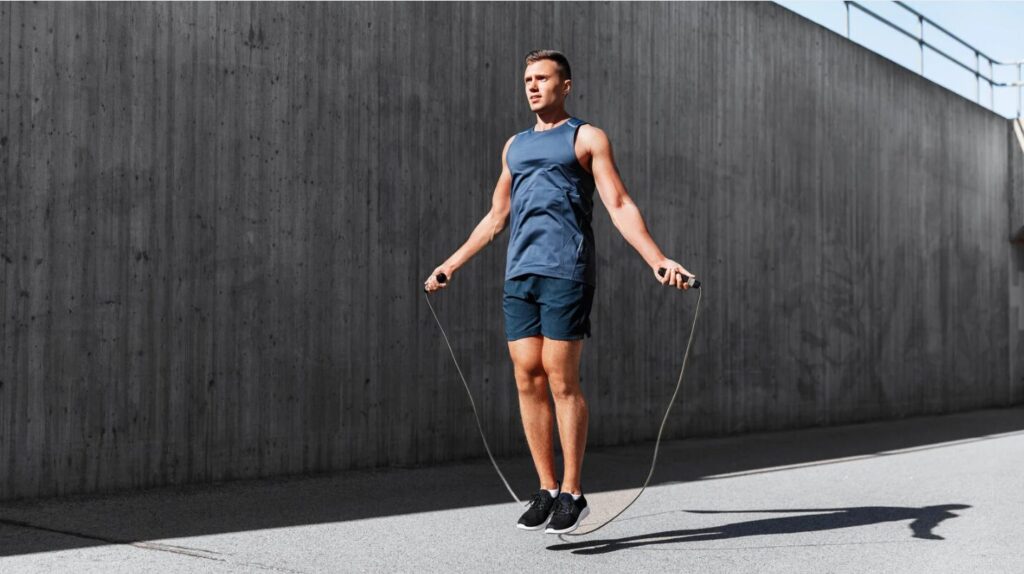Jump rope has long been part of boxing preparation. Its simplicity is deceptive; however, its benefits go beyond basic conditioning. Jump rope workouts sharpen footwork, agility, speed, and power, and correctly executed drills improve boxing rhythm, balance, and athletic coordination.

Why Boxers Use Jump Rope Workouts
Boxers do jump rope exercises for several reasons outside the ring. Footwork and agility are among the main objectives. The repetitive nature of jumping keeps the athlete on the balls of the feet, similar to the quick, light foot movement of boxing.
These workouts increase cardiovascular endurance. Boxing demands high output over several rounds, and jump rope conditioning builds stamina so fighters can remain intense throughout a match.
Other benefits include explosive power and coordination. Movements such as double under cause rapid lower body engagement and hand and foot synchronization. Over time, this strengthens the lower body muscles, tendons, and stabilizers for power generation and injury prevention.

Best Jump Rope Workouts for Boxers
Basic Boxer Skip
The basic boxer skip is an essential jump rope drill modeled after the natural rhythm and shifting foot patterns in the ring. It involves alternating the feet in a relaxed, rhythmic motion as the rope passes underneath. Boxers learn balance and timing while remaining light on their feet.
Progression involves increasing speed and variations, such as shifting weight more strongly from one foot to the other, which sharpens coordination and fluid movement.
Double Unders for Explosiveness
Double unders are among the most challenging but rewarding jump rope drills for explosive power. In this exercise, the rope goes under the feet twice for every jump, and you need to do a quick wrist movement and then a big jump.
It serves boxers well because it simulates rapid bursts of energy with the explosive engagement of the calves, quads, and core. Proper timing, posture, and wrist control are important in double unders.
Jumping too high or using too many arm movements instead of wrist flicks can cause fatigue and inefficiency.
High-Knee Jump Rope Drill
High-knee drills elevate the intensity of a jump rope session. By raising their knees to waist level with each jump, boxers can significantly improve their foot speed and agility. This drill also forces greater core engagement, promoting balance and control.
Gradual increases in duration and speed make this exercise an effective way to simulate the fast-paced demands of a fight while reinforcing reactive footwork and conditioning.

Side-to-Side Jumps
Lateral movement is crucial in boxing, and side-to-side jumps with a jump rope directly aid lateral footwork. In this exercise, the athlete jumps laterally from one side to the other while maintaining continuous rope swings.
Incorporating side-to-side jumps builds ankle stability and coordination in preparation for frequent directional changes inside the ring. Over time, this drill also increases reflexes and lower-body control.
Sprint Intervals with Jump Rope
Boxing-specific stamina and explosiveness require interval training. Sprint intervals with a jump rope alternate maximal-intensity jumping with short rest or slower recovery periods.
Such training mirrors intensity fluctuations in a fight, where brief lulls follow short bursts of high output. Typical interval workouts include thirty seconds of high-speed jumps followed by fifteen seconds of slow jumping over several rounds to build endurance and explosiveness simultaneously.
How to Structure a Jump Rope Routine for Boxing
Tune the jump rope routine to complement your broader boxing training. A typical weekly routine may involve jumping rope three to five times per week and varying the emphasis between endurance, footwork, and explosive drills.
Jump rope work, combined with shadowboxing, pad work, and strength training, produces complete athletic development. Beginners can start with simple drills and progress to double unders and sprint intervals as their coordination improves.
Monitor progression carefully to avoid overuse injuries and to maintain balance across training components.
Common Mistakes and How to Avoid Them
Unhealthy posture and incorrect technique, such as excessive arm motion or flat-footed jumping, reduce the effectiveness of the workout and increase injury risk. Good form involves upright posture, light foot contact, and wrist-driven rope movement.
Overtraining can cause shin splints and calf tightness. Warming up, stretching, and recovering can prevent these risks.
A frequent error is the lack of variety in workouts. Relying on just one or two jump rope drills may cause plateaus. Multiple variations, speeds, and footwork patterns keep training interesting and promote full development.

Frequently Asked Questions
How often should boxers use a jump rope in their training routine?
Boxers typically incorporate jump rope workouts three to five times weekly, depending on their training intensity and goals. Balancing jump rope drills with other boxing-specific exercises ensures optimal results without overtraining.
Which jump rope exercises are best for improving footwork?
The basic boxer skip, side-to-side jumps, and high-knee drills are particularly effective for enhancing footwork and agility and reinforcing the quick, reactive movement patterns essential in boxing.
What is the benefit of double unders for boxers?
Double unders develop explosive power, cardiovascular endurance, and coordination. They train the lower body to produce rapid force while challenging overall timing and rhythm.




